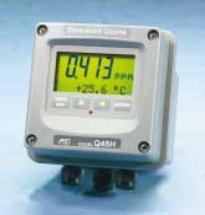- Phone: 800-492-1252
- Fax: 440-368-3569
- E-mail: info@spartanwatertreatment.com
Knowing the dissolved ozone concentration is a critical parameter for many ozone water treatment applications. It’s also important for controlling the industrial ozone generator. While ozone residual can be measured via wet chemical methods, dissolved ozone sensors and monitors can provide highly accurate, real-time measurements in a labor efficient manner. Additionally, the output from these devices can be monitored at a distance and can provide a feedback signal for controlling the overall ozone water treatment process.
As with other ozone related monitors, there are two basic techniques employed with these sensors. The first employs a gas permeable membrane and electrochemical cell. A very small portion of the treated water is based by a sensor with the gas permeable membrane. Ozone diffuses through the membrane and contacts an electrode. The current that flows is proportional to the amount of dissolved ozone. Electronics in the monitor converts this signal to mg/l of ozone.
The other type of monitor uses UV to detect and measure ozone. This type of system is sensitive to other contaminants in the water that might interfere with the measurement, for example anything that might impinge above the transmittance of UV through water. This can include particles and organic chemicals. Finished drinking water would be expected to carry a fairly low level of these materials, but in applications like wastewater, they might significantly interfere with the results.
An indication of ozone concentration can be made using an oxidation reduction potential (ORP) probe and monitor. Reading of positive values above the background level would be an indication of ozone residual. While they can not directly give the ozone residual concentration they are inexpensive. They will also experience interference from other oxidants in the water. On the other hand, ORP is a good indicator of anti microbial conditions. Greater than positive 650 mV is a good indication of disinfected water. Lower values have been used to gauge the quality of cooling water and other water treatment applications.
As noted above, simple wet chemical test methods are available for measuring dissolved ozone. Standard Methods (4500 – O3 B Colorimetric Method) provides the procedure for the Indigo Trisulfonate Method. The indigo dye is beached by ozone, the greater the reduction in color at a specific wavelength the more ozone present. This method is considered the most accurate wet chemistry method and is widely employed in the drinking water industry and approved by the EPA.
In selecting a method for monitoring ozone in water consideration should be given to the need for real-time data, automation requirements, cost, government regulations and accuracy required for the measurements.

An example of a dissolved ozone monitor sold by Spartan Environmental Technologies is the Q45H/64 monitor. The specifications are shown below:
Contact Spartan if you have any questions about monitoring ozone in water.